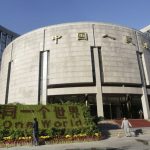
Among thirty-two market participants polled this week, 29 or 91% expected the People’s Bank of China (PBOC) to keep the borrowing cost of one-year medium-term lending facility (MLF) loans unchanged, while the remaining three projected a marginal interest rate cut.
The interest rate on the MLF loans currently stands at 2.5%.
Additionally, 26 or 81% of all respondents predicted that the central bank would inject fresh funds to exceed the maturing 650 billion yuan ($91.11 billion) worth of the MLF loans on Friday.
“We look for an outsized MLF to buffer liquidity demand emanating from bond sales and loans; if there is no outsized MLF, then a reserve requirement ratio (RRR) cut is probably needed,” said Frances Cheung, rates strategist at OCBC Bank.
Over recent months, China has started to unleash fresh stimulus to shore up the economy. In a surprise move, Beijing in late October approved 1 trillion yuan of sovereign bond issuance for this year – its first such budget deficit expansion in a fiscal year in 23 years – and passed a bill to allow local governments to frontload part of their 2024 bond quotas.
The PBOC injected a net 600 billion yuan of cash via MLF loans into the banking system in November, the biggest monthly increase since December 2016.
Expectations of an interest rate reduction has increased slightly as China has been facing heightened deflationary pressure, with consumer prices falling the fastest in three years in November while factory-gate deflation deepened.
“The main barrier to PBOC rate reductions since the middle of this year has been the strength of the dollar,” said Julian Evans-Pritchard, head of China economics at Capital Economics.
“However, U.S. yields have fallen and the renminbi has strengthened recently. The currency has now returned to levels that the PBOC is more comfortable with, which should open the door to a resumption of rate cuts.”
With China’s economy sputtering and the U.S. dollar surging until recently, the yuan has had a volatile year, having weakened 6.14% to the dollar at one point before giving back some of the losses on views that U.S. interest rates have peaked.
On Wednesday, the Federal Reserve took a decidedly dovish tilt by flagging rate cuts were on the way next year.
The yuan strengthened 2.55% in November, its best month this year, but it is still down about 3.3% year-to-date.
China will step up policy adjustments to support an economic recovery in 2024, state media said, following the annual Central Economic Work Conference held from Dec. 11-12, during which top leaders set economic targets for next year.
“This signals that the Chinese leadership wants to put more weight on the economy than it did earlier this year,” said Tommy Wu, senior China economist at Commerzbank (ETR:CBKG).
“Monetary policy will continue to be about providing sufficient but not excessive liquidity. This means any rate cuts and stimulus measures will likely be modest.”
($1 = 7.1341 Chinese yuan)
To read the full article, Click Here

